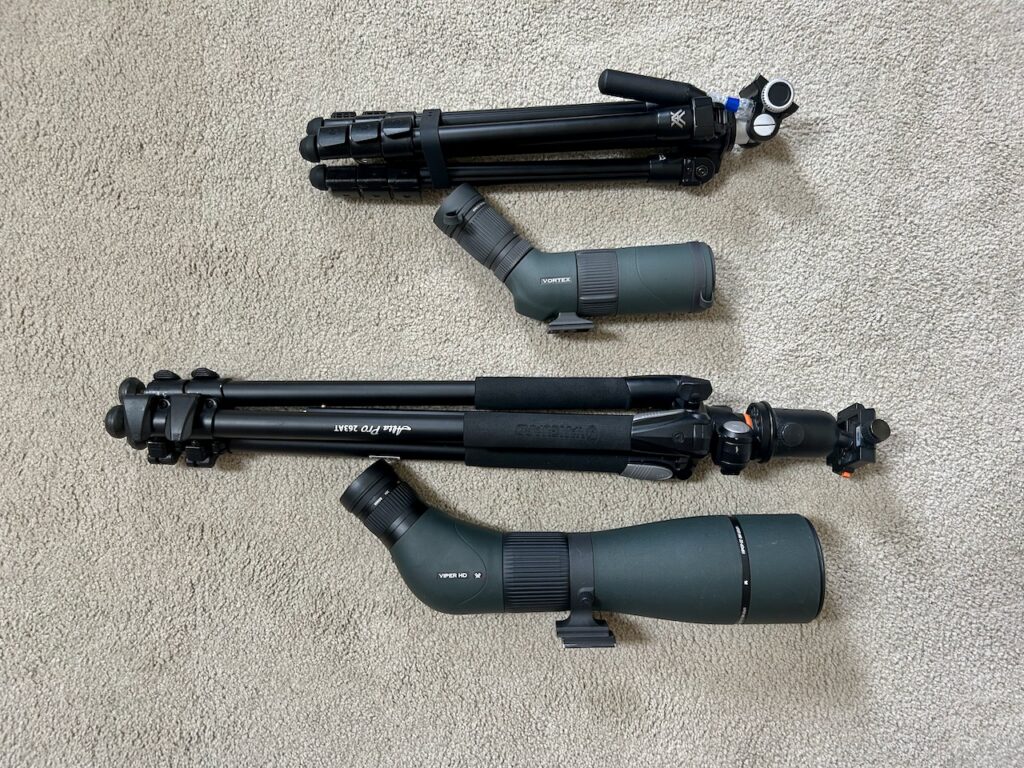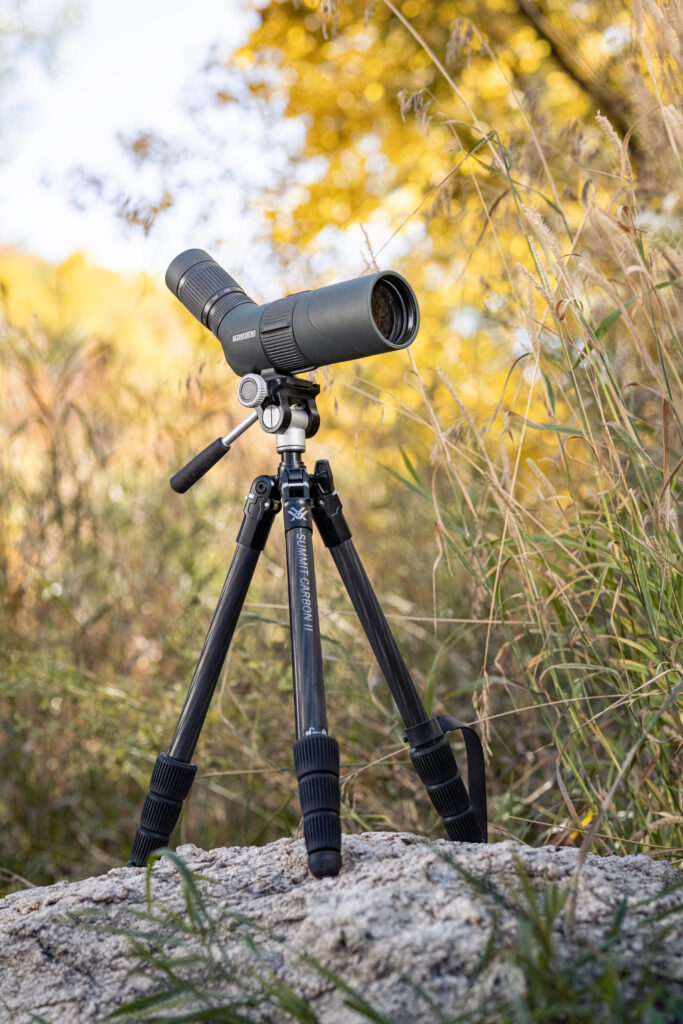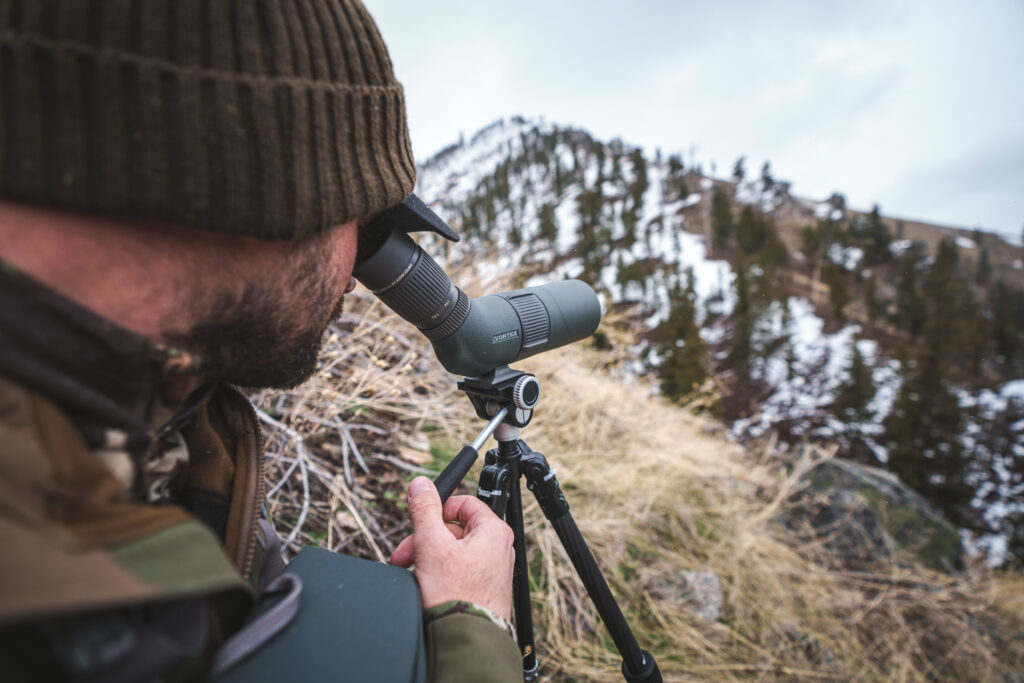When it comes to equipment, birders tend to follow similar progressions. With binoculars, for instance, most of us start by borrowing any binoculars at hand. From there, we buy our own binoculars, focusing more on the sale price than the quality. Then, one day, we happen to look through a friend’s really good binoculars and it’s like “Whoa! I’ve got to save up for these!” If you’re at that point, check out our two recent reviews of binoculars that we highly recommend:
Birders, though, also go through a progression with spotting scopes, from not thinking we need one at all to wanting to get the best possible scope we can afford. But birders who travel a lot also progress to another step: getting a scope that is easy to travel with. Which is where I currently find myself. After going through the typical birder “evo-scopo-lution,” Braden and I bought ourselves a Viper HD 20-60X85 a couple of years ago. I can’t sing the praises of this scope highly enough. I like it so much that I lugged it with me on recent trips to California (see our post “Chasing Migrants”) and Canada (see our post “Birding Victoria, BC”). The problem? It’s not exactly travel-friendly. At eighteen inches (45 cm) long and weighing in at five pounds (2.3 kg), just the scope alone demands some tough packing decisions. Add in five pounds for a sturdy tripod, and just like that, you’ve increased your travel calculations by an awkward ten-plus pounds!
I was discussing this dilemma with a Vortex dealer account manager recently and I asked him, “Hey, do you have any good travel scope/tripod combos I can try out?” Three days later I received a Vortex Razor HD 13-39X56 scope with a Vortex Mountain Pass tripod. Even better, I was just about to head out on a trip to central Montana where I would be able to put it through its paces (see our last post, “Hi-Line Report”). But before I critique this dynamic duo, let me give you some basic stats:
* Fully assembled, the Razor HD 13-39X56 scope measures only 10.5 inches long—short enough to fit into almost any backpack. When the eyepiece is removed, it shrinks to an incredible 8 inches!
* The Razor HD 13-39X56 weighs only 1 lb. 14 oz—less than one of those silly two-pound weights many of us buy for rehab exercises.
* The Mountain Pass tripod measures just over 21 inches—also short enough to slip into many backpacks—and weighs almost exactly 3 pounds.

In other words, the entire combo comes in at an almost feather-light 5 pounds—less than half of what I am used to lugging around. This alone gave me a huge crush on it! But (suspense building), how did it perform? I had the chance to use the scope in both optimal and stormy conditions, so let me take those one at a time.
Optimal Conditions: Basically, I could not be more pleased with the Razor HD 13-39X56/Mountain Pass combo in great conditions. For its size and weight, the scope’s optics are terrific, giving sharp, clear images at distances of at least a couple of hundred yards. In fact, under the vast majority of conditions, interference from heat waves and similar air turbulence will distort the image before the scope’s distance precision is exceeded. Birds and other animals look like they are almost right in front of you in all their crisp, colorful glory. What’s more, I took the combo out on a two-mile jaunt at a local birding hotspot and hardly paid it any attention as I strolled along with it resting over my shoulder. This is in sharp contrast to my other, heavier scope/tripod combo, which Braden and I have to frequently trade carrying as it digs into our shoulders.

Stormy Conditions: During my recent trip to Bowdoin National Wildlife Refuge, I unfortunately encountered very gusty conditions. As you might imagine, using the scope/tripod combo proved more challenging. The optics, of course, stayed the same, but the combo’s light weight began to be a factor. I had to hold down the tripod with one hand to reduce shake enough to get on distant ducks and other birds—but this is a problem even with my heavier scope/tripod combo and every other combo that I have used in windy weather. To help compensate for this, the Mountain Pass tripod comes with a hook from which you can hang a stabilizing weight, but that means you have to bring this along with you (or use a boot, young child, or other handy hangable weight). I did not try this myself, but I’d guess that even with the weight, gusty conditions will pose a challenge. That’s no criticism of the combo—just a fact of birding life.

To help matters, you don’t have to use the lightweight Mountain Pass tripod. The Razor HD 13-39X56 is so good that you might make it your only scope purchase, and if you do, you might consider buying a heavier tripod that will deliver better performance in rough conditions.

However, the point of this article is lightweight travel, and I have to say that the Razor HD 13-39X56/Mountain Pass combo strikes a wonderful balance between weight, magnification, and quality. An added advantage to this combo is that because Vortex makes both products, you won’t need an additional mounting plate to affix the scope to the tripod. Mounting plates generally are a pain in the rump, always coming loose at inopportune moments, so for me this is a significant advantage.
You are probably asking yourself, “Does the Vortex Razor HD 13-39X56 scope have enough magnification for distant birds?” With a maximum magnification of 39, the answer is that it certainly has less than what I have on my 60X85 scope. That said, I did not feel very limited by this. Again, in my experiences atmospheric disturbances are usually more likely to limit your observations than the power of this scope.

More about the tripod: I should point out that before receiving the Mountain Pass tripod, I was a strict adherent to “ball head” tripod heads, ones that allow you to quickly tilt and rotate the scope in any direction with a single control knob. The Mountain Pass head, though, comes with a “pan and tilt” head, but unlike some other pan and tilt heads I’ve used, both the pan and tilt also are controlled by a single knob. This makes the whole thing almost as easy to use as a ball head. To lock down the swivel of the head, you just hand-tighten the knob further. I suspect that this may wear out or get stripped over time, but as I’ve mentioned in other posts, Vortex’s lifetime warranty has you covered.
Like many other tripods, the Mountain Pass features four-part, telescoping legs that allow it to adjust to almost any height (though folks over 6-feet tall may want a taller tripod). The tripod legs also have levers that allow them to splay extremely wide for observing, say, a grouse lek at eye level.
Pricing: I have been so taken with this scope that I’ve neglected to mention the price. Although listed considerably higher, the Vortex Razor HD 13-39X56 scope can currently be purchased for right around $1000 while the tripod runs about $150. These are not insignificant sums, but are a great value for the quality you get—as anyone who has used cheaper scopes and tripods will quickly learn.
Bottom line: I love the Vortex Razor HD 13-39X56/Mountain Pass combo and am deeply upset that I have to return it to Vortex. Who are they to ask for their equipment back, anyway? I suspect, however, that I will be purchasing this combo in the future and am already looking forward to using it on a host of future travel birding adventures.


